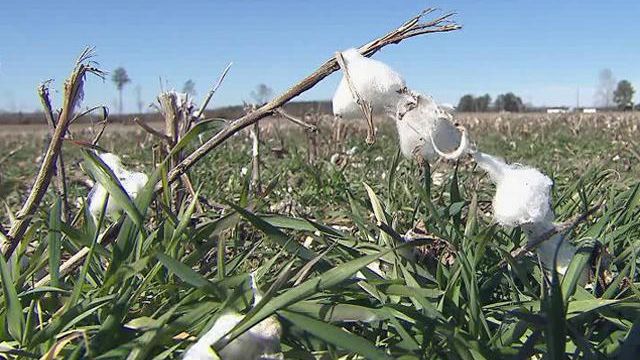Despite demand, cotton a gamble for NC farmers
North Carolina farmers are planting more cotton after a new forecast predicts the fiber will remain in short supply this year while demand stays strong.
Posted — Updated“I'll personally stay in it until I die out or retire out,” he says of his job.
The lifelong farmer hedges his bets each growing season, deciding how much of his Halifax County farm to devote to soybeans, corn, peanuts and cotton.
“Peanuts have gone up some but not nearly enough to compete with cotton,” he says.
This year, he and other farmers in eastern North Carolina, where the crop yields its greatest harvest, are putting their money on cotton and planting more.
That’s because cotton prices are jumping after a new forecast predicts the fiber will remain in short supply this year while demand stays strong.
Prices per pound for the Southeast market have jumped from 66 cents a year ago to $1.68 on Monday because of decreased supply around the world, especially in emerging nations where more cotton is being consumed.
Nationwide, cotton prices nearly doubled in 2010 after adverse weather in several countries cut into harvests. Since Jan. 7, the price is up 24 percent.
The National Cotton Council of America is predicting supplies will be tight even though U.S. acreage planted this year is expected to increase about 14 percent.
Like other commodities, the price of cotton is driven by a combination of supply, demand and interest from investors. Investors want to own pieces of commodities like they own stock in companies, and they purchase commodity futures, which affects the price the farmer receives.
Looking at current numbers, a farmer could gross about $350 an acre with soybeans and bring in three times that much with cotton.
“It's about what kind of yield can you get with cotton versus corn or soybeans,” North Carolina Agriculture Commissioner Steve Troxler says. “The farmers are taking a sharp pencil and determining what is my best opportunity to make a profit and where the least amount of risk is going to be.”
It can be a gamble.
Cotton costs more money to plant and harvest. Farmers also set their prices with contracts before planting, so if they set their price at $1.50, for example, and the value goes up later, they lose out on the higher price.
“I think it’s going to be a real quandary for our farmers to decide what they are not going to plant for the first time and a real long, long time,” Troxler says. “All of our commodities are attractive right now."
Hamill says cotton is a growing gamble he's willing to take.
“I don't think anybody knows where it's going to go, but the demand is great,” he says.
North Carolina farmers produced 970,000 bales of cotton in 2010, a 27 percent increase from a year earlier, according to the North Carolina Department of Agriculture & Consumer Services.
They also harvested 540,000 acres of cotton last year, compared with 370,000 in 2009. There could be as much as a 20 percent increase this year, Troxler says.
“We expect a pretty large increase in cotton acreage in North Carolina because of the attractiveness of the price and the potential profit margin out there,” he says.
He adds that since 2000, the state has lost 1 million acres of farmland to development, which could be a challenge for farmers.
“There’s going to be a lot of competition for land,” he says. “We know that. There’s going to have to be a lot of good decisions made, because there’s a limited amount of land to grow those crops on.”
• Credits
Copyright 2024 by Capitol Broadcasting Company. All rights reserved. This material may not be published, broadcast, rewritten or redistributed.





